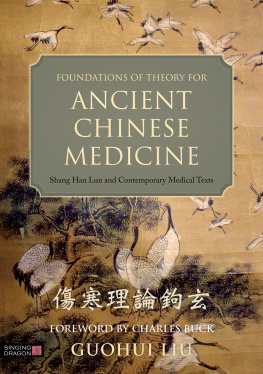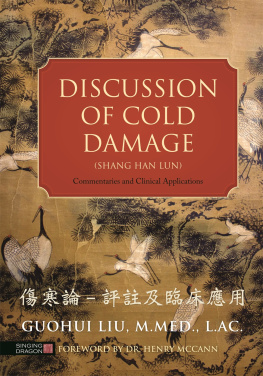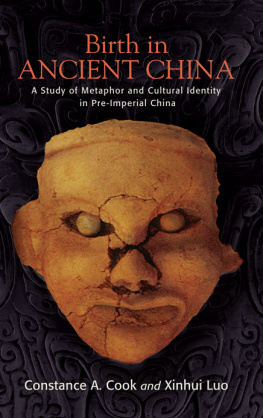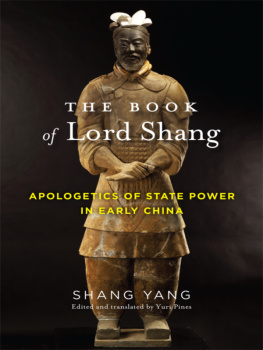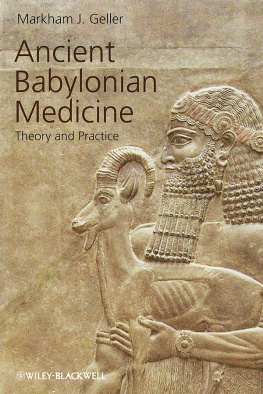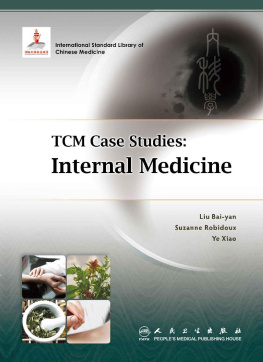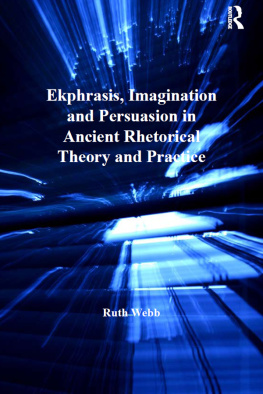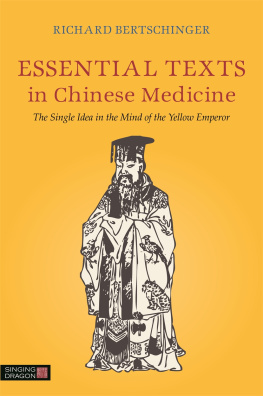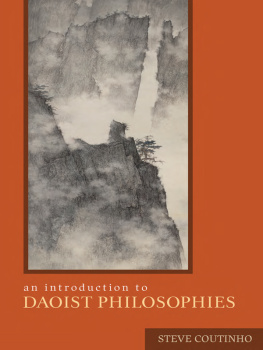
FOUNDATIONS OF THEORY FOR
ANCIENT CHINESE MEDICINE
by the same author
Discussion of Cold Damage (Shng Hn Ln )
Commentaries and Clinical Applications
Guohui Liu
Foreword by Dr. Henry McCann
ISBN 978 1 84819 254 6
eISBN 978 0 85701 200 5
of related interest
Acupuncture and Chinese Medicine
Roots of Modern Practice
Charles Buck
Foreword by Barbara Kirschbaum
ISBN 978 1 84819 159 4
eISBN 978 0 85701 133 6
Heavenly Stems and Earthly BranchesTianGan DiZhi
The Heart of Chinese Wisdom Traditions
Master Zhongxian Wu and Dr Karin Taylor Wu
Foreword by Fei BingXun
ISBN 978 1 84819 151 8
eISBN 978 0 85701 158 9
Gold Mirrors and Tongue Reflections
The Cornerstone Classics of Chinese Medicine Tongue
DiagnosisThe Ao Shi Shng Hn Jin
Jing Lu, and the Shng Hn She Jian
Ioannis Solos
Forewords by Professor Liang Rong and Professor Chen Jia-xu
ISBN 978 1 84819 095 5
eISBN 978 0 85701 076 6
Essential Texts in Chinese Medicine
The Single Idea in the Mind of the Yellow Emperor
Richard Bertschinger
ISBN 978 1 84819 162 4
eISBN 978 0 85701 135 0
Foundations of Theory for
ANCIENT CHINESE
MEDICINE
Shng Hn Ln and Contemporary Medical Texts
GUOHUI LIU
Foreword by CHARLES BUCK

LONDON AND PHILADELPHIA
First published in 2015
by Singing Dragon
an imprint of Jessica Kingsley Publishers
73 Collier Street
London N1 9BE, UK
and
400 Market Street, Suite 400
Philadelphia, PA 19106, USA
www.singingdragon.com
Copyright Guohui Liu 2015
Foreword copyright Charles Buck 2015
All rights reserved. No part of this publication may be reproduced in any material form (including photocopying or storing it in any medium by electronic means and whether or not transiently or incidentally to some other use of this publication) without the written permission of the copyright owner except in accordance with the provisions of the Copyright, Designs and Patents Act 1988 or under the terms of a licence issued by the Copyright Licensing Agency Ltd, Saffron House, 610 Kirby Street, London EC1N 8TS. Applications for the copyright owners written permission to reproduce any part of this publication should be addressed to the publisher.
Warning: The doing of an unauthorised act in relation to a copyright work may result in both a civil claim for damages and criminal prosecution.
Library of Congress Cataloging in Publication Data
Liu, Guohui, 1956
Foundations of theory for ancient Chinese medicine : shang han lun and contemporary medical texts /
Guohui Liu.
pages cm
Includes bibliographical references and index.
ISBN 978-1-84819-262-1 (alk. paper)
1. Medicine, Chinese. 2. Medicine, Chinese--History. 3. Herbs--Therapeutic use. I. Title.
R601.L67964 2015
615.321--dc23
2014047511
British Library Cataloguing in Publication Data
A CIP catalogue record for this book is available from the British Library
ISBN 978 1 84819 262 1
eISBN 978 0 85701 211 1
CONTENTS
FOREWORD
When, in 1983, I first attempted to read Hong-yen Hsus English language translation of the Shng Hn Ln I was already aware of the line in the Yijing that reads go hunting without the forester and you will soon be lost in the forest. Not for a moment did it occur to me that, with the resources available to me at the time, it would be near impossible to simply read and understand this cornerstone of classical Chinese medicine. Indeed, I had no inkling that I was actually lost in the forestin the beginners blissful ignorance I imagined it possible to find my own way.
At that same time, on the other side of the world, I guess that Guohui Liu was also wrestling the Shng Hn Ln for its secrets. His linguistic and cultural proximity to the primary sources meant that he was in a very much better position to do so. In addition, Lius own father was a respected Chinese medicine scholar. If further qualification were needed we could note also that, as a long-standing faculty member of the Oregon College of Oriental Medicine, Professor Liu is accustomed to communicating the ideas of Chinese medicine to English speakers. Evidence of this we have already seen in an earlier English language masterwork, his Warm Diseases: A Clinical Guide .
As all serious students of this medicine know, the Shng Hn Z Bng Ln is the very foundation stone of scholarly Chinese herbal medicine practice and is the source of roughly a quarter of the core formulary taught to undergraduates. All undergraduates learn the rudiments of these formulas in the early years of our studies, but if we aspire to high-level practice we need to fully understand their use in the context of the explanatory models used by the Shng Hn Ln author Zhang Ji (aka Zhang Zhong-Jing c. +150 to 219).
Despite its pre-eminent position in Chinese medicine, the Shng Hn Ln has not been without its critics. I first stumbled across these controversies when, on a clinical trip to Shanghai in 1990, a senior physician assured me that the Shng Hn formulas, despite their elegance, mostly do not work today as our patients differ from those in the Han Dynasty. This seemed a challenging thing to say. Later I became aware that he was stating his position in a very longstanding debate wherein some Ming Dynasty practitioners asserted that the ancient classical formulas style did not suit illnesses suffered by patients in their era. We might say that this debate continues today and has, alongside the increased sophistication of practitioners and scholars in the here, spread to the West.
To hold an informed position in this requires that we have a proper overview of the complexities of scholarly literature over the past thousand yearsthe insiders understanding of Shng Hn theory that Professor Guohui Liu provides here. So, by explicating the story for us, and presenting his personal scholarly interpretation, he allows us to more properly understand the issues. Liu is our forester offering guidance through the dense Shng Hn literature forest.
When we have learned to read the language and structure of the classic Chinese herb formulas, we gain the sense that those from the Shng Hn Ln possess a characteristic elegance and luminosity. Here we find numerous exemplars on the use of contrasting properties such as matching the cold, sinking effect of sh go with the xuan -dispersing effect of xing rn , or the warm pungent dispersal of gu zh with the cool contracting nourishment of bi sho. We can sense the focus his formulas have on specific energetic niches in the body and the way he applied the three methods (exterior release, emesis, precipitation). In addition, we can appreciate in the Shng Hn formulas his specific adjustment of the bodys qi mechanism and his sophisticated insight into the ba gang principles long before the idea had been formally distilled from the classic texts. If we are reasonably adept in Chinese medicine we can appreciate these aspects but, as we learn from this book, it is possible to peer deeper into Zhang Jis mastery.
As an aside, it is sometimes forgotten that a significant facet of the historical practice of Chinese medicine is the fight against epidemic and pestilential disease and there is confusion about the dual use of Shng Hn Ln theory inside and outside of this context. In modern times we can get a diluted sense of the dread associated with these diseases by reflecting on the realities of words such as plague, Ebola and cholera but few of us have actually witnessed first hand the darkness of such fatal pandemics. The three-millennia-old Shang and Zhou Dynasty ji g wn writings on tortoiseshell and bone mention disease years and everything under the sun must have been tried to save life by combating these diseases. In his foreword to the Shng Hn Z Bng Ln, written in about +219, Zhang Ji wrote that he had witnessed the death of the majority of his relatives in an epidemic and this motivated his life quest for a medical system that was more effective in combating such strife. He adopted a schema taken from the S Wn that outlined the day-by-day progress of febrile disease and refined this on the basis of his medical scholarship and experience. Some of the herb formulas he used were probably self-penned, whereas others, such as gu zh tng, are believed to have been in existence in the medical traditions that existed in centuries prior to his own, traditions that are now lost.
Next page
